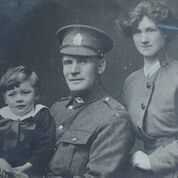L/Cpl
John Neill
Informations sur naissance
|
Date de naissance: 03/08/1882 |
|
Lieu de naissance: Belfast, Antrim, Irlande, Royaume-Uni |
Informations générales
|
Profession: Chauffeur (machine à vapeur) |
Informations service militaire
|
Pays: New Zealand |
|
Force armée: New Zealand Expeditionary Force |
|
Rang: Lance Corporal |
|
Numéro de service: 15229 |
|
Incorporation date: 07/04/1916 |
|
Incorporation nom de lieu: Trentham, Wellington, New Zealand |
|
Unités: — Otago Regiment, 2nd Bn. (Dernière unité connue) |
Informations sur décès
|
Date de décès: 12/10/1917 |
|
Lieu de décès: Bellevue 's, Graventafel, Belgique |
|
Cause du décès: Killed in action (K.I.A.) |
|
Âge: 35 |
Cimetière
|
Tyne Cot Cemetery Parcelle: XXV Rangée: G Tombe: 12 |
Distinctions et médailles 2
|
British War Medal Médaille |
|
Victory Medal Médaille |
Points d'intérêt 3
| #1 | Lieu de naissance | ||
| #2 | Lieu d'enrôlement | ||
| #3 | Lieu du décès (approximatif) |
Mon histoire
Lance Corporal John Neill, a fireman from Mornington, Dunedin, served in “D” company, 2nd Battalion Otago Regiment, part of the 2nd New Zealand Brigade. John originated from Belfast, Northern Ireland. He was married to Jeanne Anderson and had a son, John Richard. He enlisted in April 1916. In November 1916 he joined his unit at the front lines. In February he was appointed Lance Corporal.
On 12 October 1917, the New Zealanders were to attack. The main goal was to reach to northern outskirts of the Passchendaele village. The 2nd New Zealand Brigade was to attack with the 2nd Battalion Otago Regiment, the 1st Battalion Otago Regiment and the 1st Battalion Canterbury Regiment. The 2nd Bn. Canterbury Regiment was in reserve. The three objectives were allotted in this order.
The attack began at 5.25 a.m. with the 2nd Otago’s positioned at the front and thus leading the assault. The first objective was a line running from Friesland Farm to Source Wood. On their right was the Ravebeek stream, that could be used as a guideline to reach Passchendaele.
Shortly after the men advanced through Marsh Bottom towards Bellevue, they got into difficulties because of uncut wire entanglements that lay in front of the jumping off line. The opening barrage had failed to destroy the wires. The only gap in the wire was at a single point on the sunken Gravenstafel Road. While some soldiers tried to cut some paths through the wires, many soldier went to that single open point, which turned out to be a death trap. The area of the Bellevue Spur was overloaded with German defences and pillboxes. And the German machine-guns mowed the New Zealanders down, who massed at the road. The other Battalions faced the similar problems, so they also couldn’t get any further and failed to reach the Red Line. The 12th of October 1917 will be remembered as one of the most darkest days in the history of the New Zealand.
Lance Corporal Neill, 35, was reported wounded and missing. A Court of Inquiry held in 1918 concluded that he died on the battlefield. His remains were eventually exhumed just northwest of the German positions at Bellevue. He was interred in Tyne Cot Cemetery.
On 12 October 1917, the New Zealanders were to attack. The main goal was to reach to northern outskirts of the Passchendaele village. The 2nd New Zealand Brigade was to attack with the 2nd Battalion Otago Regiment, the 1st Battalion Otago Regiment and the 1st Battalion Canterbury Regiment. The 2nd Bn. Canterbury Regiment was in reserve. The three objectives were allotted in this order.
The attack began at 5.25 a.m. with the 2nd Otago’s positioned at the front and thus leading the assault. The first objective was a line running from Friesland Farm to Source Wood. On their right was the Ravebeek stream, that could be used as a guideline to reach Passchendaele.
Shortly after the men advanced through Marsh Bottom towards Bellevue, they got into difficulties because of uncut wire entanglements that lay in front of the jumping off line. The opening barrage had failed to destroy the wires. The only gap in the wire was at a single point on the sunken Gravenstafel Road. While some soldiers tried to cut some paths through the wires, many soldier went to that single open point, which turned out to be a death trap. The area of the Bellevue Spur was overloaded with German defences and pillboxes. And the German machine-guns mowed the New Zealanders down, who massed at the road. The other Battalions faced the similar problems, so they also couldn’t get any further and failed to reach the Red Line. The 12th of October 1917 will be remembered as one of the most darkest days in the history of the New Zealand.
Lance Corporal Neill, 35, was reported wounded and missing. A Court of Inquiry held in 1918 concluded that he died on the battlefield. His remains were eventually exhumed just northwest of the German positions at Bellevue. He was interred in Tyne Cot Cemetery.
Sources 6
|
Auckland Cenotaph https://www.aucklandmuseum.com/war-memorial/online-cenotaph/record/C11356?n=15229&w=World%20War%20I%2C%201914-1918&ordinal=0&from=%2Fwar-memorial%2Fonline-cenotaph%2Fsearch Sources utilisées |
|
CWGC https://www.cwgc.org/find-war-dead/casualty/464082/neill,-john/ Sources utilisées |
|
NZEF-project https://nzef.adfa.edu.au/showPerson?pid=187854 Sources utilisées |
|
The Long Long Trail http://www.longlongtrail.co.uk/ Sources utilisées |
|
The Official History of the Otago Regiment N.Z.E.F. in the Great War 1914-1918 ", Byrne A.E., Dunedin, Wilkie & Co Ltd., pg. 207 - 228. Sources utilisées |
|
The Third Ypres Passchendaele. The Day-by-Day Account ", McCarthy C., London, Arms & Armour Press, 1995, pg. 115-116 Sources utilisées |
